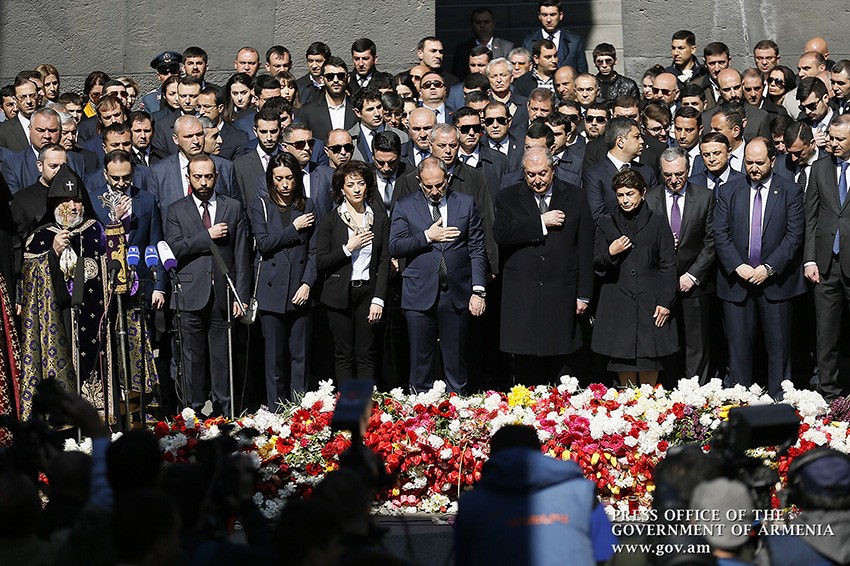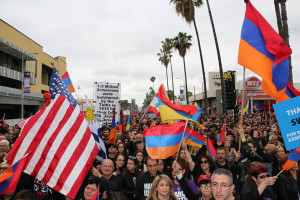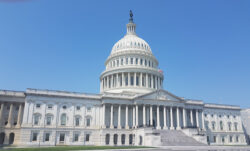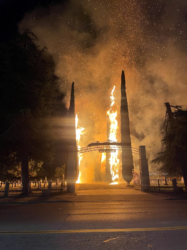Armenia Marks 104th Anniversary of the Genocide

YEREVAN (RFE/RL) — Tens of thousands of people marched to the Tsitsernakabert memorial in Yerevan and laid flowers there on Wednesday as Armenia marked the 104th anniversary of the 1915 genocide of Armenians in Ottoman Turkey.
As always, the annual procession began with a prayer service held by Catholicos Karegin II, the supreme head of the Armenian Apostolic Church, by the eternal fire of the hilltop memorial overlooking the city center. The ceremony was attended by President Armen Sarkissian, Prime Minister Nikol Pashinyan and other senior state officials.
“It is the day to recall once again the tragedy of our compatriots who had suffered ferocities and had been expelled from the land of their ancestors … to tell the world once again about the Genocide — the most hideous crime against humanity — and to call for soberness and a fight against denial,” Sarkissian said in a written statement issued on the occasion.
“Impunity that followed the Armenian Genocide had opened the doors for other grave crimes against humanity and genocides: remember the Holocaust, the tragedies in Cambodia and Rwanda,” he said.
A separate statement released by Pashinyan noted not only the slaughter of some 1.5 million Armenians but also the destruction of Armenian cultural heritage in the Ottoman Empire.
“We were consistently deprived of the land on which Armenian culture and Armenian identity were formed and developed over thousands of years. The cultural heritage that constitutes the Armenian identity — thousands of schools, churches and monasteries — was erased from the face of the earth.
The carriers of the essence of the Armenian culture – intelligentsia and clergy – were annihilated. It was a huge blow not only to the Armenian people, its culture and its cultural type, but also to the human civilization, as whole.
A unique and peculiar layer that was part of the global culture is irreversibly lost. The genocides of Armenians, Greeks and Assyrians irrevocably changed the cultural image of the whole region. Was this not a crime against humanity?
The perpetrators killed our poets, those who constituted our conscience, the basis of our identity. Therefore, we must consistently struggle to preserve our essence, our species. If we commit to oblivion their memory, if we forget about their cultural heritage, we will betray our essence.
By keeping their memory alive and fighting for justice, we will gain immortality. Therefore, we will be consistent in promoting the international recognition of the Armenian Genocide.” Read Pashinyan’s statement.
The U.S. Ambassador to Armenia, Lynne Tracey, also attended that ceremony. She told journalists she came to the memorial to honor memories of the victims.
“The United States does not deny historical facts, and the fact is that what took place in 1915 was one of the worst mass atrocities of the twentieth century. But we remain encouraged by the resiliency of the Armenian people and that is also what today is about,” Tracey said.
U.S. President Donald Trump used similar wording in a statement, steering clear of the word “genocide” but referring to the Armenian-language term Meds Yeghern, or “great calamity.”
Later on, Prime Minister Pashinyan and Mrs. Anna Hakobyan visited the Armenian Genocide Museum-Institute and got acquainted with the exhibits on display at the exposition referred to as “150-year-old witnesses of the Armenian Genocide: Komitas Vardapet and Hovhannes Tumanyan.”
Dedicated to the 150th anniversary of great Armenian intellectuals Komitas Vardapet and Hovhannes Tumanyan, the exposition seeks to inform the public about the history of the Armenian Genocide.
The exhibition has two key aspects: on the one hand, it presents the friendly and creative ties between the two geniuses, and on the other hand, the impact the Armenian Genocide on their lives. The bilingual (in Armenian and English) exposition, consisting of eight parts, comprises both original materials from the collections of the Armenian Genocide Museum Institute and materials and photographs from various archives and museums of Armenia.
Authored by Bitlis resident Agavni Mkrtchyan, who had survived the genocide, a video on how Tumanyan organized assistance for refugees in Echmiadzin in 1915 is presented for the first time. There are exceptional exhibits, including a beads-scores made by Varderes Atanesyan during the years in exile with the engraved names of 99 intellectuals, including the name of Komitas Vardapet on the first bead.
The exhibition is accompanied by Araks Mansuryan’s performance of Komitas’s unfinished Anush opera, which is based on the eponymous poem by Tumanyan. Sketches from Komitas series, authored by famous Armenian painter Sarkis Muradyan, are also presented. The exposition will be on until August 30, 2019.







